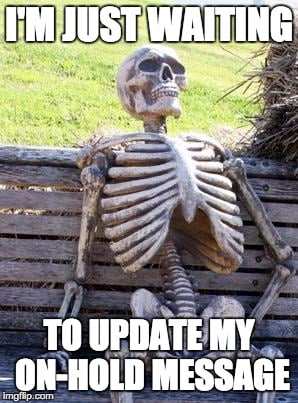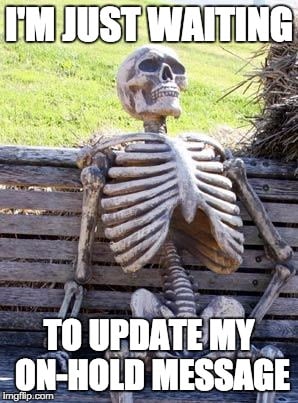 When was the last time you called your business and listened to the on-hold messaging?
When was the last time you called your business and listened to the on-hold messaging?
Don’t feel guilty or ashamed if the answer to that question is, “not recently” or “I don’t remember.”
For business owners and managers, it can be easy to overlook and forget about hold messaging. It’s unseen, a hidden touchpoint that while directly connected to customers is often very disconnected from business owners and decision makers.
It’s lack of visibility makes it easy to set it and forget it. But neglecting this customer touchpoint is a mistake that can negatively impact your sales, customer satisfaction, and brand value.
The only way to effectively use on-hold messaging is to start thinking about it as more than a recorded message and give it the attention it needs by regularly updating and revising your content.
On-Hold Messaging Is Marketing Tool — Only If You Regularly Update
Your hold message is a direct line to engaged customers — prospects that are on the line trying to connect with you. This is an incredible marketing opportunity.
Companies spend almost all of their marketing budgets to get customers to engage with their business. But they spend almost nothing (only 6% of marketing budgets) on marketing to them when they are right in the palm of their hand.
Hold messaging is a prime place for marketing to a highly engaged, targeted customer. But using hold messaging as a marketing tool won’t work if the message is outdated and tired.
You wouldn’t launch a marketing campaign, post ads in newspapers or on billboards, then neglect to change them for years at a time.
You shouldn’t do that with on-hold messaging either.
By regularly updating your content, you can leverage this marketing opportunity and:
- introduce new products and services as they are released
- highlight upcoming events
- promote new specials, sales, and promotions
- include seasonal specials
- show the personal side of your business (include updates about what you and your staff have done to give back outside of work)
If you don’t regularly update these marketing messages, they become obsolete and out-dated. Plus, customers will begin to ignore the message if they have heard it multiple times.
 On-Hold Messaging Is a Sales Tool — Only If You Regularly Update It
On-Hold Messaging Is a Sales Tool — Only If You Regularly Update It
Another way to find opportunity in the extremely engaged audience who is calling your business is to sell to them.
Use on-hold message marketing as a way to spread awareness. Use on-hold message selling as a way to increase revenue.
To sell to the customers on hold, you can’t record one sales message and hope it will repeatedly bring in sales. You need to be strategic about your messaging, test what works, and regularly update so that your content does the following.
Includes Successful Cross Sales: Look at what is working in the store and see if you can get the same results on the phone. For example, if you noticed that customers in a specific department are frequently making purchases of another product, mention it in your messaging.
Motivates Customers to Take Action: Don’t just mention sales, promotions, and upsells. Be extremely clear with your audience about what they need to do to receive the benefit. Include clear call-to-actions that tell the caller exactly how they can take the next step (“ask your customer representative about…,“ “visit our website,” etc.).
Stresses Urgency: If you fail to regularly update your hold messaging, you are unable to leverage one of the best sales tools — urgency. Including specific end dates and deadlines will motivate customers to take action because they see a clear end to the opportunity.
The only way to use hold messaging as a sales tool is to regularly update and revise your information. It will allow you to test and see what works. You can add urgency, and you can ensure that your audience won’t begin to ignore the messages after they’ve heard them for the fifth or tenth time.
On-Hold Messaging Is Customer Service Tool — Only If You Regularly Update
While your hold messaging can certainly serve your business by creating marketing and sales opportunities, don’t forget its other prime purpose.
Hold messaging should always aim to serve the customer and help them find what they need in the shortest possible time.
You can’t do that if you fail to regularly update your messaging and make the following mistakes.
- Giving Your Customers and Callers Message Fatigue: Customers will begin to ignore and even annoy repeated messaging. Don’t force your audience to listen to the same message for months or worse, years.
- Not Delivering the Information Your Customers Need: As your business evolves, so will the questions that customers have about your services and products. Regularly update your hold messaging so it includes the most relevant FAQs.
- Delivering Information That Is Out-of-Date: Quite possibly the worst mistake you can make with hold messaging is delivering the wrong information. By frequently updating your messaging, you can be sure that all of your content is relevant, timely, and accurate.
Your hold message is a tool to help you serve your customers. Don’t spend time setting up a message then negate the work by failing to update it again. Keep your messaging working for you and your customers by consistently revising and renewing content.
So, How Often Should You Update Hold Messaging?
When you create your hold message content, you should plan to revise it monthly, quarterly, semiannually, or annually.
Although we recommend that your hold messaging strategy should be updated at least 4 times per year.
If you update less than that, your hold message strategy will not be as effective. You will miss out on connecting with a highly engaged audience and fail to use your message to improve your sales, marketing campaigns, and customers service.
Are you ready to upgrade and improve your hold messaging so that you can better serve your business and customers? Learn more about how you can bring on-hold services to your business with a free, no-obligation consultation with a Spectrio specialist.
During your session, you’ll learn how to create strategic messaging, select voice talent, and write scripts.
